Excessive solids buildup in livestock manure lagoons is generally due to manure or non-manure materials which cannot be degraded or broken down by the bacteria in the lagoon. Some solids accumulation, which usually occurs as a relatively uniform layer of "mineralized," digested manure at the lagoon bottom, is normal in properly operating lagoons. If manure entering the lagoon has a small particle size, and is relatively highly degradable by bacteria, then the solids accumulation is usually not excessive. Manure from confinement swine operations has these characteristics. So, the solids buildup in properly sized hog lagoons is not usually excessive. However, swine lagoons which are undersized, or have become undersized due to expansion, may experience excessive solids buildup because of reduced bacterial activity.
Lagoons that have received non-degradable material over a period of years will usually show signs of excessive solids buildup. Such materials may include bedding (straw, wood shavings, sawdust, sand, etc.), as well as undigested fibrous materials in the manure itself. Dairy lagoons are particularly susceptible because they receive relatively high amounts of these materials. Solid materials which are more dense than water settle to the bottom of the lagoon, and can create "mounds" of built-up solid material at several places in the lagoon. Materials less dense than water stay on the lagoon surface, and form floating mats or crusts. These crusts can support vegetative growth, and in extreme cases, the lagoon surface may become completely covered with thriving vegetation.
Preventing solids buildup in lagoons
The most positive way to prevent solids buildup in manure lagoons is to prevent non-degradable materials from entering the lagoon in the first place. Solids separation equipment, and devices such as settling basins or picket dams, can prevent much of the problem-causing solids from entering the lagoon.
Most livestock operations have not invested in solids-separating equipment, however, and in these cases equipment and procedures must be selected to remove accumulated solids from the lagoon.
Solids removal equipment
Equipment that is suitable and effective for removing solids from lagoons has been developed in both the municipal/industrial and agricultural arenas. Equipment developed for the municipal/industrial arena generally provides for a short-term cleanout of the lagoon; while the agricultural equipment may require more time with repeated pumping activities.
Municipal and industrial equipment
Equipment and techniques for cleaning solids from municipal and industrial lagoons has been available for many years. Procedures using this equipment are designed to clean the lagoon in a short period (within a few days) on a "one-time" basis. Figure 1 shows a dredging machine typically used to remove solids from municipal and industrial lagoons. This material is then pumped to the application area and injected as shown in Figure 2, or spread with traveling-gun irrigation equipment. If the land application area is distant from the lagoon, the material may be hauled and spread with applicators, as shown in Figure 3.
 Figure 1
Figure 1
Dredge used to remove solids from municipal and industrial lagoons.
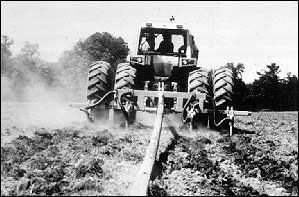 Figure 2
Figure 2
This tractor and chisel tool bar inject a solids slurry pumped directly from a lagoon.
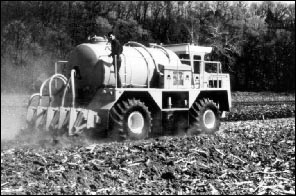 Figure 3
Figure 3
Tank trucks with injector units are used to land-apply solids slurry beyond pumping distance from the lagoon.
While this equipment is equally applicable to livestock manure lagoons, cost may be a prohibitive factor. Bids solicited for such a cleanout of a lagoon at the MU Foremost Dairy Farm ranged from $72,000 to $130,000 (1993 dollars). The lagoon was 2.1 acres in surface area, 17 feet deep, and was approximately half-filled with accumulated solids, with a floating crust on much of the lagoon surface.
Agricultural equipment
Generally, using agricultural equipment to remove solids from a lagoon will take more time because repeated pumping activities are required. However, ownership and operating costs of this equipment are usually less than with the municipal/industrial equipment. Thus, it is more commonly used for livestock manure lagoons. The following list identifies the equipment necessary to remove solids from livestock manure lagoons.
1
Agitator
The agitator is probably the most important piece of equipment in the solids-removal process. The agitator suspends settled solids from the lagoon bottom, and breaks up surface crusted material. Ideally, the agitator should be capable of creating a "swirl" or rotation of the entire lagoon surface. Then solids suspended near the agitator tend to remain in suspension and are carried to the pump. More than one agitator may be required on large lagoons.
Figure 4 is an example of a PTO-driven propeller agitator mounted on wheels. A three-point hitch-mounted propeller agitator is shown in Figure 5. Wheel-mounted agitators can be built longer (up to about 40 feet) to provide more "reach" into the lagoon. Propellers on these agitators are "open" with no housing, and are typically about 2 feet in diameter.
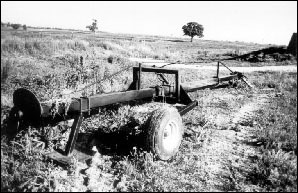 Figure 4
Figure 4
A wheel-mounted, PTO-driven propeller/agitator is used to stir and suspend solids in a lagoon.
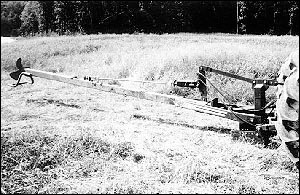 Figure 5
Figure 5
Three-point, hitch-mounted agitators are usually shorter than wheel-mounted agitators.
Agitation can also be accomplished with pumps designed with a bypass nozzle to direct water back into the lagoon. Figure 6 is an example of such a pump. These pumps offer the advantage of a chopping action as they pump, but typically do not have the flow rate and high agitation capability of the propeller-type PTO agitators.
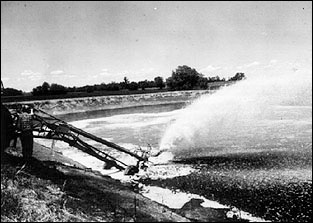 Figure 6
Figure 6
Some manure pumps are designed to agitate by directing the stream back into the lagoon with a bypass nozzle.
Considerable power is required to create the turbulence necessary to suspend solids and provide the desired swirling action in a lagoon. Most propeller-type agitators require tractors in the 100 to 150 horsepower range for best operation.
2
Chopper pump
Long hay, bedding and other fibrous material in lagoons will plug suction intake lines and impellers, in many cases. For this reason, a chopper pump is often used as the first device in the pumping circuit. It will reduce the size of solids and minimize the chances of plugging downstream. In order to eliminate intake pipes, these pumps are usually located directly in the lagoon (submersible type). Generally, these pumps do not have the pressure necessary to operate irrigation or injection application equipment. Hence they are connected to feed a booster pump which provides the necessary higher pressure.
Figure 8 is an example of a chopper pump which may be used in pumping as well as agitating. For pumping, the pump would be shifted from the bypass agitation mode (Figure 6) so that it would feed a booster pump at the side of the lagoon. A disadvantage of this scheme is that the lagoon is not being agitated while the chopper pump is feeding the booster pump. The lagoon should be agitated during pumping to move solids from other areas to the pump. Also, a separate power unit (tractor) is required to operate the chopper pump in this case.
Another type of chopper pump is hydraulically driven by the tractor serving the booster pump. Figure 7 shows such a pump, which is connected to the booster pump by a flexible hose of sufficient size. This type of pump may be suspended in the lagoon with a float, as shown, or may rest on the lagoon bottom, in some cases. These pumps are usually equipped with a bypass valve which allows agitation in the region of the pump. An advantage of this scheme is that a single power unit can be used to operate both the booster pump and the chopper pump. A second tractor can then be used for agitation while the lagoon is being pumped. These chopper pumps must be capable of delivering the flow rate required (typically about 500 gpm at 15 to 20 feet head for the chopper pump). Hydraulic requirements for these pumps may be relatively high (20 to 30 gpm at 2000 to 2500 psi) and must be considered when selecting equipment and power units. The combined power requirements of both the chopper and booster pumps must be considered in selecting the power unit, if both are to be operated by the same power unit.
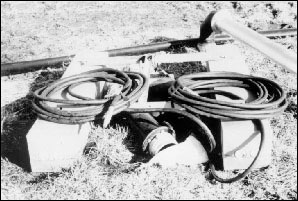 Figure 7
Figure 7
This hydraulically driven chopper pump can be suspended from the floats in the lagoon.
3
Booster pump
Since the chopper pump may provide sufficient flow — but not pressure — to operate the system, a booster pump is used to raise the pressure required by the distribution system being used. Typically, traveling-gun distributors will require pressures of 100 to 140 psi at the booster pump, depending on system design. Injection-type operations may require less pressure.
Booster pumps are typically PTO-driven (540 or 1000 rpm) and mounted on wheels to facilitate moving. Flotation tires help moving in muddy or soft areas. Figure 8 shows a booster pump connected to a chopper pump at a lagoon. Booster pumps should be selected with impellers designed to handle vegetative fibers and solids.
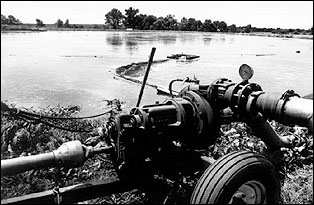 Figure 8
Figure 8
This booster pump is fed by a chopper pump submerged in the lagoon.
4
Pipe
Conventional aluminum irrigation pipe is suitable for handling slurries containing manure solids. The pipe should be sized to handle the desired flow rate with an acceptable friction loss. The pipe should be equipped with positive locking connectors to minimize the chances of breaking or leakage at the joints.
If buried PVC pipe is used to handle slurries with high solids content, it should be flushed with clean water after the slurry pumping is finished. Otherwise, the settled solids left in the pipe may cause plugging problems.
5
Traveling gun applicator
Irrigation traveling guns modified to handle manure slurries with high solids content can be used to remove solids from lagoons. Conventional irrigation traveling guns may be powered by an integrally-mounted winch unit, which is driven by a water turbine or piston using the water being pumped. Water with high solids content may plug these devices; so traveling guns used for handling slurries must be powered in some other way. Figure 9 is a traveling gun designed to be pulled by a cable and winch unit mounted on a tractor, at the end of the irrigated area. Other traveling guns may be powered by a small internal combustion engine and winch unit mounted on the traveling gun itself. These cable-tow traveling guns are fed by a flexible "drag" hose (Figure 10), which is pulled behind the gun as it moves across the field. Such hoses are typically up to 660 feet in length, allowing for a total irrigated run of approximately one-fourth of a mile. Travel speeds can be varied to complete the quarter-mile run in 6 to 10 hours, and thus adjust the depth of slurry applied to the land. Wetted diameters of 300 to 350 feet are typical of traveling guns. This provides a coverage of about 10 acres per "setting" with the quarter-mile run. Typically, operating pressures of 80 to 100 psi are required at the gun for proper application.
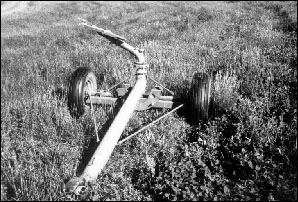 Figure 9
Figure 9
This traveling gun is pulled by a cable-and-winch unit mounted on a tractor.
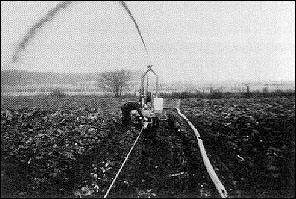 Figure 10
Figure 10
Cable-tow traveling guns are fed by a flexible hose, which drags behind the gun.
Another type of traveling gun that can be used to handle manure slurries is the "hard-hose" traveling gun. With this unit, the gun is pulled across the field by the feed hose as the hose is wound onto a large drum (Figure 11.) The primary advantages of these units are:
- Less time and labor are required to move the system from one set to the next
- Irrigation can be done in several different directions with one setting.
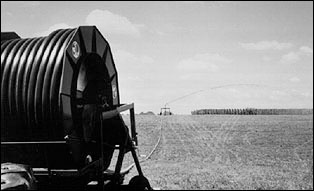 Figure 11
Figure 11
"Hard hose" traveling guns are pulled across the field as the hose winds onto a large drum.
6
Injection applicator
Manure slurries can be applied with injection units mounted on a tool bar, pulled behind a tractor as shown in Figure 12. The injection unit is fed by a drag hose similar to the cable-tow traveling gun. The primary advantages of injecting are the control of odors, and the reduction of fertilizer/nutrient losses that occur when manure is surface-spread. Obviously, injecting will require an adequate power unit (tractor) in the field.
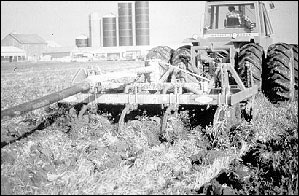 Figure 12
Figure 12
Injection of solids reduces odors and helps retain fertilizer nutrients.
7
Manure tankwagon
In some cases, manure tankwagons may be used to haul solids from a lagoon to the land application area. However, it is usually much more feasible to pump rather than haul the material, due to the large volumes involved. For example, a 500 gpm pumping system operating over a 10-hour day will irrigate a total of 300,000 gallons, or about 11 acre-inches. A 3,000-gallon tankwagon operating over the same 10-hour day with a 30-minute round trip time from lagoon to field and back (including loading and unloading) would handle only 60,000 gallons, or 2.2 acre-inches.
Operational considerations
With the equipment noted previously, solids-removal from livestock manure lagoons involves:
- Properly agitating the lagoon to suspend solids
- Chopping or macerating the solids so that they can be handled by the pumping equipment
- Pumping and distributing the solids in slurry form over the land application area.
This process is reasonably straightforward, but requires that operating personnel be familiar with the equipment and procedures necessary for most efficient use. Following are some operational considerations derived from experiences in removing solids from livestock manure lagoons.
Agitation
Proper agitation is the most important step in effective removal of solids from lagoons. Proper agitation breaks up surface crusts, and suspends solids which have settled to the bottom of the lagoon. Agitation should be sufficient to cause the lagoon to "swirl" and carry suspended solids to the chopper pump. Agitators are effective in suspending solids within a radius of 60 to 100 feet. Experience shows that solids are suspended within this area in 20 to 30 minutes of agitation; longer agitation time at this location does not suspend many more "new" solids. Thus the agitator is used most efficiently if moved to a new location after this time period. The effectiveness of the agitator in suspending solids can sometimes be judged by the appearance of the slurry discharging from the traveling gun. A dark or black slurry indicates a high degree of solids suspension, while a lighter color indicates less solids suspension.
Because lagoons must remain impermeable in order to protect groundwater, agitation should not scour the bottom. This is usually accomplished by keeping the agitator 2 to 3 feet above the lagoon bottom so that the high-liquid velocities generated near the propeller do not affect the clay liner. Agitators can be equipped with a base-plate, or "foot" (Figure 4) to limit the depth to which it can be lowered.
By positioning the agitator in the lagoon at an angle, as shown in Figure 13, the desired "swirl" effect can usually be obtained. Wind can affect agitation, especially if there is floating crust and vegetation on the lagoon surface. If wind effects are present, it is important to agitate "with the wind."
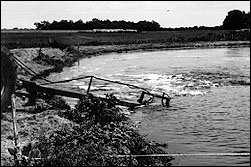 Figure 13
Figure 13
Placing the agitator at an angle creates a swirl effect in the lagoon.
Chopper and slurry booster pump
If a separate chopper pump (Figure 6) is being used, the pump is simply placed in the lagoon at an appropriate location, and the discharge is connected by a suitable hose to the slurry booster pump. The two pumps are then operated in "series."
If a hydraulically driven chopper pump (Figure 7) is being used, the pump can be suspended from a flotation device. Some pumps are designed to rest on the lagoon bottom. Obviously, a chopper pump used in this manner must have the capacity to feed the booster pump at the desired flow rate.
Care should be exercised in bringing the series-connected chopper and booster pumps to full flow condition. The best practice is to slowly increase the speed of each pump at the same time. This will ensure that each pump is operating under stable conditions and that the flow is properly matched to the capabilities of each pump. Hydraulically driven chopper pumps should be operated with a system equipped with a flow control valve, so that pump speed can be easily regulated. The use of a chopper pump to feed the slurry booster pump eliminates the sometimes troublesome task of priming the slurry booster pump.
Traveling gun applicator
The traveling gun should be operated to achieve a target application depth (nutrient application rate) with no runoff. If soil conditions are wet, the gun travel speed should be increased, which, in turn, decreases the depth of application and reduces the chances for runoff. Such wet conditions may require several "fast" passes of the traveling gun so that the total desired application depth is obtained with several shallow applications. The following equation calculates the proper gun travel speed and application depth to obtain the desired nutrient application rate.
| S = | C x F x 43.56 R x W | D = | 1.605 x F W x S |
S = gun travel speed, feet per min
C = nutrient concentration in material being pumped, pounds per 1000 gallons
F = pumping rate through traveling gun, gallons per min
R = desired nutrient application rate on land, pounds per acre
W = irrigated width, or gun lane spacing, feet
D = depth of material applied, inches
Example
Laboratory analysis of agitated solids in a lagoon shows a value of 4 pounds nitrogen per 1,000 gallons of agitated material. A traveling gun rated at 550 gallons per minute is being used with a lane spacing of 330 feet. What gun travel speed should be set to obtain a nitrogen application rate of 150 pounds per acre? What depth of material will be applied?
| S = | 4 x 550 x 43.56 150 x 330 | = 1.9 feet per min |
| D = | 1.605 x 550 330 x 1.9 | = 1.4 inches |
Note
The desired application could be obtained with two passes with a travel speed of 1.9 x 2 = 3.8 feet per minute with an application depth of 0.7 inches per pass.
Although traveling guns are tested and reliable devices for manure application, their use should be monitored closely. Their relatively high flow rates offer significant potential for pollution, should the traveling gun stop (winch unit malfunction) or overturn. Care should be taken when operating traveling guns on rolling terrain, over terraces and on sloping ground. The reactive effect of material discharging from the nozzle results in a considerable sideways force on the gun. This force can cause the gun to slide sideways or travel in an unintended path, if the gun cart is not heavy enough to counter the force. Sometimes weights are added to the traveling gun cart, or the tires are filled with fluid to increase stability. Traveling guns are usually most vulnerable to improper action at the beginning of a run. At this point, the stabilizing effect of high cable tension, countered by the large force of pulling the drag hose, is not fully developed.
Injection applicator
Injection applicators should be operated in suitable soil conditions. The furrows opened by the injector knives or sweeps should close behind the applicator to retain nutrients and minimize odor release. The use of the injection applicator requires a driving pattern similar to that shown in Figure 14. The mainline in this scheme may be rigid pipe, or may be a flexible "hard hose" (Figure 11) that is reeled in as the injection unit is operating. This procedure allows more acres to be covered per "set." The operator of an injection applicator must have some means of stopping the flow being pumped to the applicator, so that the unit can be raised out of the ground for turning, or to allow stopping for some other reason. This is sometimes accomplished with radio-controlled bypass valves at the booster pump. The injector is also equipped with a valve which automatically interrupts flow as the unit is raised out of the ground.
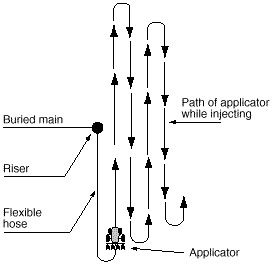 Figure 14
Figure 14
An injection applicator requires a driving pattern similar to that shown above.
Travel speed with an injection applicator is important in obtaining the desired nutrient application rate. The following equations calculate the proper applicator travel speed and gallons per acre to obtain the desired nutrient application rate.
| S = | C x F x 0.495 R x W | G = | F x 495 S x W |
S =injection applicator travel speed, miles per hour
C = nutrient concentration in material being pumped, pounds per 1,000 gallons
F = pumping rate through applicator, gallons per minute
R = desired nutrient application rate on land, pounds per acre
W = effective injection applicator width, feet
G = gallons injected per acre
Example
Laboratory analysis of agitated solids in a lagoon shows a value of 4 pounds of nitrogen per 1,000 gallons of agitated material. An injection applicator rated at 550 gallons per minute with an effective width of 10 feet is being used. At what speed should the operator drive the applicator to obtain a nitrogen application rate of 150 pounds per acre, and how many gallons per acre will be applied?
| S = | 4 x 550 x 0.495 150 x 10 | = 0.7 miles per hour |
| G = | 550 x 495 0.7 x 10 | = 38,900 gallons |
Manure slurries which are dilute (less than 5 percent solids) are usually most feasibly handled by irrigation, rather than injection, because of the large amount of water included with the nutrients.
Personnel requirements
Equipment used for solids removal should be managed by personnel familiar with proper set-up and operating procedures. Since it is often impossible for the operator at the pump to visually observe the irrigation gun as the system is activated, it is advantageous to have two people, with two-way radio communication, available for start-up. Experience has shown that at least one person should be available to frequently monitor and check the performance of the equipment as it is pumping. This will enable quick shut-down of the pump if a malfunction causes a potential pollution problem. Also, the agitator should be moved as needed during pumping to suspend solids at several points in the lagoon. The availability of two people for system set-up, and knock-down will greatly increase the efficiency of pumping operations.
Nutrient considerations
The long-term buildup of solids in a livestock manure lagoon results in a significant stockpiling of nutrients, which are then land-applied in the solids removal operation. A nutrient-management plan should be developed to provide the proper application of nutrients, at agronomic rates which protect surface and groundwater.
Estimating the amount of nutrients
In order to develop a nutrient-management plan, it is necessary to make some estimate of the amount of nutrients which will be land-applied in a solids-removal operation. This can be accomplished by probing the lagoon at a sufficient number of locations to determine the solids build-up profile. This profile can then be used to estimate the volume of solids in the lagoon. Samples of the solids should be taken and analyzed for the major fertilizer nutrients. Table 1 shows typical nutrient levels in the solids layer of swine and dairy lagoons.
Table 1
Nitrogen, phosphorus, and potassium levels in the solids layer of swine and dairy lagoons, percent wet basis
| Dry matter | Total Kjeldahl nitrogen | Ammonia nitrogen | Phosphorus | Potassium | |
|---|---|---|---|---|---|
| Swine lagoon solids | 22.5 | 0.40 | 0.10 | 0.30 | .019 |
| Dairy lagoon solids | 19.0 | 0.23 | 0.035 | 0.042 | 0.011 |
Source
Average of several analyses. Values may vary significantly.
After the volume of solids, and the nutrient levels have been determined, the total amount of nutrients to be land-applied can be estimated. The following equation estimates the weight of nutrients in a lagoon solids layer based on solids volume and nutrient level.
N = P x V x 0.699
N = weight of nutrient in lagoon solids layer, pounds
P = nutrient concentration level in solids, percent w.b.
V = volume of lagoon solids layer, cubic feet
Nutrient management plan
A nutrient-management plan for land application of manure solids should be based on agronomic best management practices. Soil tests should be taken on the proposed application area, and realistic yield goals should be selected for the crops being grown. This data can be used to estimate the proper nutrient and solids application rate. The following example illustrates a method of estimating land area requirements for application of solids from a lagoon.
Example
A lagoon serving a 150-cow dairy was constructed with a volume of 750,000 cu. feet A probing procedure has determined that the lagoon is approximately half-filled with solids. A laboratory analysis of the solids shows a nitrogen content of 0.25 percent. Soil test and crop recommendations for the proposed site suggest a nitrogen application rate of 140 pounds per acre. An estimated 50 percent of the nitrogen applied will be available to the crop. How many acres should be planned for the solids removal operation.
Calculate the estimated amount of nitrogen in the solids.
N = 0.25 x (750,000 ÷ 2) x 0.699 = 65,500 pounds nitrogen in solids
Calculate the acres required at 140 pounds per acre.
Acres = (65,500 x 0.5) ÷ 140 = 233 acres